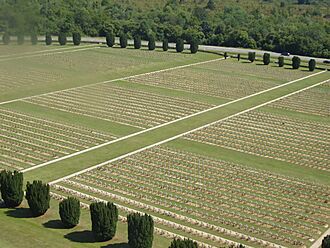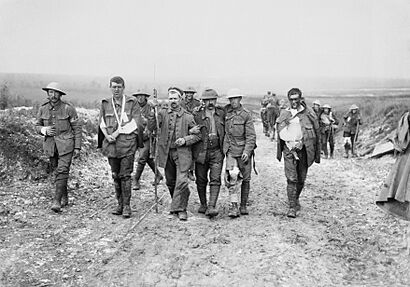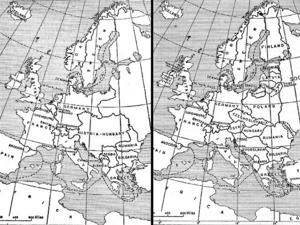World War I casualties facts for kids
The total number of military and civilian casualties in World War I was about 40 million: estimates range from around 15 to 22 million deaths and about 23 million wounded military personnel, ranking it among the deadliest conflicts in human history.
The total number of deaths includes from 9 to 11 million military personnel. The civilian death toll was about 6 to 13 million. The Triple Entente (also known as the Allies) lost about 6 million military personnel while the Central Powers lost about 4 million. At least 2 million died from diseases and 6 million went missing, presumed dead. This article lists the casualties of the belligerent powers based on official published sources.
About two-thirds of military deaths in World War I were in battle, unlike the conflicts that took place in the 19th century when the majority of deaths were due to disease. Nevertheless, disease, including the 1918 flu pandemic and deaths while held as prisoners of war, still caused about one third of total military deaths for all belligerents.
Contents
Classification of casualty statistics

Casualty statistics for World War I vary to a great extent; estimates of total deaths range from 9 million to over 15 million. Military casualties reported in official sources list deaths due to all causes, including an estimated 7 to 8 million combat related deaths (killed or died of wounds) and another two to three million military deaths caused by accidents, disease and deaths while prisoners of war. Official government reports listing casualty statistics were published by the United States and Great Britain. These secondary sources published during the 1920s, are the source of the statistics in reference works listing casualties in World War I. This article summarizes the casualty statistics published in the official government reports of the United States and Great Britain as well as France, Italy, Belgium, Germany, Austria and Russia. More recently the research of the Commonwealth War Graves Commission (CWGC) has revised the military casualty statistics of the UK and its allies; they include in their listing of military war dead personnel outside of combat theaters and civilians recruited from Africa, the Middle East and China who provided logistical and service support in combat theaters. The casualties of these support personnel recruited outside of Europe were previously not included with British war dead, however the casualties of the Labour Corps recruited from the British Isles were included in the rolls of British war dead published in 1921. The methodology used by each nation to record and classify casualties was not uniform, a general caveat regarding casualty figures is that they cannot be considered comparable in all cases. First World War civilian deaths are "hazardous to estimate" according to Micheal Clodfelter who maintains that "the generally accepted figure of noncombatant deaths is 6.5 million."
Casualties in the borders of 1914–1918
| Nation | Population (millions) | Combat deaths and missing in action (included in total military deaths) | Total military deaths (from all causes) | Civilian deaths (military action and crimes against humanity) | Increase in civilian deaths (malnutrition and disease excluding Influenza pandemic) | Total deaths | Deaths as % of population | Military wounded |
|---|---|---|---|---|---|---|---|---|
| Allies and co-belligerents of World War I | ||||||||
| 5.0 | 61,527 | 59,330 to 62,149 |
59,330 to 62,149 |
1.2% to 1.2% |
152,171 | |||
| 7.2 | 56,638 | 56,639 to 64,996 |
1,963 | 58,639 to 66,996 |
0.8% to 0.9% |
149,732 | ||
| 315.1 | 64,449 | 64,449 to 73,905 |
64,449 to 73,905 |
0% to 0% |
69,214 | |||
| 1.1 | 18,166 | 16,711 to 18,060 |
16,711 to 18,060 |
1.5% to 1.6% |
41,317 | |||
| 0.2 | 1,204 | 1,204 to 1,570(included with UK) |
1,204 to 1,570 |
0.6% to 0.8% |
2,314 | |||
| 6.0 | 7,121 | 7,121 to 9,726 |
7,121 to 9,726 |
0.1% to 0.2% |
12,029 | |||
| 45.4 | 744,000 | 887,858 | 16,829 | 107,000 to 400,000 | 867,829 to 1,011,687 |
1.9% to 2.2% |
1,675,000 | |
|
380.0 | 953,104 | 949,454 to 1,118,264 |
18,829 | 107,000 | 1,077,283 to 1,244,093 |
0.3% to 0.3% |
2,101,077 |
| 7.4 | 38,170 | 38,170 to 58,637 |
23,700 | 62,000 | 123,870 to 144,337 |
1.7% to 2% |
44,686 | |
| 39.6 | 1,150,000 | 1,357,000 to 1,397,800 |
40,000 | 300,000 to 600,000 | 1,697,000 to 1,737,800 |
4.3% to 4.4% |
4,266,000 | |
| 4.8 | 5,000 | 5,000 to 26,000 |
150,000 | 155,000 to 176,000 |
3.2% to 3.7% |
21,000 | ||
| 35.6 | 460,000 | 460,000 to 709,000 |
3,400 | 332,000 to 589,000 | 1,052,400 to 1,301,400 |
3% to 3.7% |
947,000 to 1,050,000 | |
| 53.6 | 300 | 300 to 4,661 |
300 to 4,661 |
0% to 0% |
907 | |||
| 0.5 | 3,000 | 3,000 to 13,325 |
3,000 to 13,325 |
0.6% to 2.7% |
10,000 | |||
| 6.0 | 7,222 | 7,222 | 13 | 82,000 | 89,235 | 1.5% | 13,751 | |
| 7.5 | 335,706 | 250,000 to 335,706 |
130,000 | 200,000 | 580,000 to 665,706 |
7.7% to 8.9% |
120,000 | |
| 175.1 | 775,369 to 1,700,000 | 1,700,000 to 2,254,369 |
410,000 | 730,000 | 2,840,000 to 3,394,369 |
1.6% to 1.9% | 3,749,000 to 4,950,000 |
|
| 4.5 | 127,500 | 300,000 to 450,000 |
450,000 to 800,000 |
750,000 to 1,250,000 |
16.7% to 27.8% |
133,148 | ||
| 92.0 | 53,402 | 116,708 | 757 | 117,466 | 0.1% | 204,002 | ||
|
806.6 | 4,833,404 | 5,186,854 to 6,433,692 |
626,699 | 3,420,000 to 3,770,000 |
9,235,553 to 10,080,391 |
1.1% to 1.2% |
11,611,271 to 12,812,271 |
| Central Powers | ||||||||
| 51.4 | 1,016,200 | 1,200,000 to 1,494,200 |
120,000 | 467,000 | 1,787,000 to 2,081,200 |
3.5% to 4% |
3,620,000 | |
| 4.5 | 87,500 | 87,500 | 100,000 | 187,500 | 3.4% | 152,390 | ||
| 64.9 | 1,800,000 | 2,037,000 | 720 | 300,000 to 763,000 | 2,198,420 to 2,800,720 |
3.4% to 4.3% |
4,215,662 | |
| 21.3 | 305,085 | 325,000 to 771,844 |
1,500,000 | 1,000,000 | 2,825,000 to 3,271,844 |
13.3% to 15.4% |
400,000 to 763,753 |
|
|
142.1 | 3,208,785 | 3,386,200 to 4,390,544 |
1,620,720 | 1,991,000 to 2,330,000 |
6,997,920 to 8,341,264 |
4.9% to 5.9% |
8,388,052 to 8,751,805 |
| Neutral nations | ||||||||
| 2.8 | See footnote re: Danes in German military | 700 | 700 | 0% | — | |||
| 0.3 | 2,800 | See footnote | ||||||
| 2.4 | 1,180 | 1,180 | 0.1% | — | ||||
| 10.5 | 2,000,000 | 2,000,000 | 19% | — | ||||
| 5.6 | 800 | 800 | 0% | — | ||||
| 0.7 to 0.8 | 70,000 | 8.75% to 10% | — | |||||
| 0.0087 | 4 | 4 | 0.05% | — | ||||
| Grand total | 959.7 | 8,042,189 | 8,573,058 to 10,824,240 |
2,250,099 | 5,411,000 to 8,100,000 |
15,000,000 to 22,000,000 | 1.7% to 2.3% |
22,101,100 to 23,665,873 |
The source of population data is: Haythornthwaite, Philip J., The World War One Source Book pp. 382–383
Casualties by post-war (1924) borders
The war involved multi-ethnic empires such as Great Britain, France, Germany, Russia, Austria-Hungary and Turkey. Many ethnic groups in these territories were conscripted for military service. The casualties listed by modern borders are also included in the above table of figures for the countries that existed in 1914. The casualty figures by 1924 post war borders are rough estimates by Russian historian Vadim Erlikman in a 2004 handbook of human losses in the 20th century, the sources of his figures were published in the Soviet era and in post-Soviet Russia. According to the 1914–1918 Online Encyclopedia "In addition to losses suffered by African military personnel and the laborers supporting their operations, very large, but unknown numbers of African civilians perished during the war." They made an estimate of civilian losses in Africa of 750,000 based on the study by the Vadim Erlikman. They noted that Erlikman's figures are based on the work of the Russian demographer Boris Urlanis, they noted that these estimates were "imprecise" and "could be used to provide a frame of reference for further inquiry". The Oxford History of World War One notes that "In east and central Africa the harshness of the war resulted in acute shortages of food with famine in some areas, a weakening of populations, and epidemic diseases which killed hundreds of thousands of people and also cattle."
The following estimates of Austrian deaths, within contemporary borders, were made by a Russian historian in a 2004 handbook of human losses in the 20th century. Total dead 175,000: including military losses 120,000 with the Austro-Hungarian forces and POW deaths in captivity of 30,000. Civilian dead due to famine and disease were 25,000.
The following estimates of Belarusian deaths, within contemporary borders, were made by a Russian historian in a 2004 handbook of human losses in the 20th century. Total dead 130,000: including military losses 70,000 with the Russian forces. Civilian dead were 60,000.
The following estimates of Ukrainian deaths, within contemporary borders, were made by a Russian historian in a 2004 handbook of human losses in the 20th century. Total dead 590,000: including military losses 450,000,(Erlikman did not break out military losses between Austro-Hungarian and Russian armed forces). Civilian dead were 140,000.
The Belgian Congo was part of the Kingdom of Belgium during the war. A Russian historian Vadim Erlikman in a 2004 handbook of human losses in the 20th century based on sources published in the Soviet Union and Russia estimated a total of 155,000 deaths in the Belgian Congo during the war.
Czechoslovakia was part of Austro-Hungary during the war. The estimates of Czechoslovak deaths within 1991 borders were made by a Russian historian in a 2004 handbook of human losses in the 20th century. Total dead 185,000: including military losses 110,000 with the Austro-Hungarian forces and POW deaths in captivity of 45,000. Civilian dead due to famine and disease were 30,000. The Czechoslovak Legions fought with the armies of the Allies during the war.
Estonia was part of the Russian Empire during the war and about 100,000 Estonians served in the Russian Army. Of them about 10,000 were killed.
From 1809 Finland was an autonomous Grand Duchy in the Russian Empire until the end of 1917. Finland's autonomous status meant that Finns were exempt from conscription into the Russian Army. Approximately 800 Finns voluntarily served during World War I. According to data regarding Finnish war casualties, 317 Finns were killed between 1914 and 1917.
The following estimates of deaths, within contemporary borders, during World War I were made by a Russian historian Vadim Erlikman in a 2004 handbook of human losses in the 20th century. Erlikman's estimates are based on sources published in the Soviet Union and Russia. These numbers only include military deaths, total civilian deaths in Africa could amount up to 750,000.
 Algeria (1914 known as French Algeria): 26,000
Algeria (1914 known as French Algeria): 26,000 Vietnam (1914 known as French Indochina): 12,000
Vietnam (1914 known as French Indochina): 12,000 Mali (1914 part of French West Africa): 10,000
Mali (1914 part of French West Africa): 10,000 Morocco (1914 known as the French protectorate of Morocco): 8,000
Morocco (1914 known as the French protectorate of Morocco): 8,000 Senegal (1914 part of French West Africa): 6,000
Senegal (1914 part of French West Africa): 6,000 Guinea (1914 part of French West Africa): 2,500
Guinea (1914 part of French West Africa): 2,500 Madagascar: 2,500 military
Madagascar: 2,500 military Benin (1914 part of French West Africa): 2,000
Benin (1914 part of French West Africa): 2,000 Burkina Faso (1914 part of French West Africa): 2,000
Burkina Faso (1914 part of French West Africa): 2,000 Republic of the Congo (1914 part of French Equatorial Africa): 2,000
Republic of the Congo (1914 part of French Equatorial Africa): 2,000 Côte d'Ivoire (1914 part of French West Africa): 2,000
Côte d'Ivoire (1914 part of French West Africa): 2,000 Tunisia (1914 known as French Tunisia): 2,000
Tunisia (1914 known as French Tunisia): 2,000 Chad (1914 part of French Equatorial Africa): 1,500
Chad (1914 part of French Equatorial Africa): 1,500 Central African Republic (1914 known as French Oubangui-Chari): 1,000
Central African Republic (1914 known as French Oubangui-Chari): 1,000 Niger (1914 part of French West Africa): 1,000
Niger (1914 part of French West Africa): 1,000 Gabon (1914 part of French Equatorial Africa): 500
Gabon (1914 part of French Equatorial Africa): 500 India (French Establishments in India): 195
India (French Establishments in India): 195
Total: 82,000
The following estimates of Georgian deaths, within contemporary borders, were made by a Russian historian in a 2004 handbook of human losses in the 20th century. Georgia was part of the Russian Empire during the war and about 150,000 Georgians served in the Russian Army. Of them about 10,000 were killed.
The following estimates of deaths, within contemporary borders, during World War I were made by a Russian historian Vadim Erlikman in a 2004 handbook of human losses in the 20th century. Erlikman's estimates are based on sources published in the Soviet Union and Russia. These numbers only include military deaths, total civilian deaths in Africa could amount up to 750,000.
 Tanzania (1914 part of German East Africa): 20,000
Tanzania (1914 part of German East Africa): 20,000 Namibia (1914 known as German South-West Africa): 1,000
Namibia (1914 known as German South-West Africa): 1,000 Cameroon (1914 known as Kamerun): 5,000 military and 50,000 civilian
Cameroon (1914 known as Kamerun): 5,000 military and 50,000 civilian Togo (1914 known as German Togoland): 2,000
Togo (1914 known as German Togoland): 2,000 Rwanda (1914 part of German East Africa): 15,000
Rwanda (1914 part of German East Africa): 15,000
Total: 48,000
The following estimates of Hungarian deaths, within contemporary borders, during World War I were made by a Russian historian in a 2004 handbook of human losses in the 20th century. Total dead 385,000: including military losses 270,000 with the Austro-Hungarian forces and POW deaths in captivity of 70,000. Civilian dead due to famine and disease were 45,000.
Ireland was a part of the United Kingdom during World War I. Five-sixths of the island left to form the Irish Free State, now the Republic of Ireland, in 1922. A total of 206,000 Irishmen served in the British forces during the war. The number of Irish deaths in the British Army recorded by the registrar general was 27,405. A significant number of these casualties were from what, in 1920, became Northern Ireland. While 49,400 soldiers died serving in Irish divisions (the 10th, 16th and 36th), although not all of the men serving in these divisions were natives of Ireland and many Irish who died in non-Irish regiments are not listed. For example, 29% of the casualties in the 16th Division were not natives of Ireland. Neither does it include Irish emigrants in Britain who enlisted there and are not categorised as Irish. Australia lists 4,731 of its first World War soldiers as having been born in Ireland and more than 19,000 Irish-born soldiers served in the Canadian Corps. According to research done by John Horne of Trinity College Dublin, there are at least 30,986 soldiers who were born in Ireland that died; however, that's considered a "conservative" estimate and is very likely to raise.
The losses of Portuguese Mozambique were estimated by a Russian historian Vadim Erlikman in a 2004 handbook of human losses in the 20th century. Erlikman's estimates are based on sources published in the Soviet Union and Russia. 52,000
Poland was territory of Germany, Austria-Hungary and partially annexed by Russia, from 1795 to 1918. By late 1915, Germany had complete control over modern-day Poland. A 2005 Polish study estimated 3,376,800 Poles were conscripted into the armed forces of these countries during World War I, an additional 300,000 were conscripted for forced labor by the Germans. The Russians and Austrians forcibly resettled 1.6 to 1.8 million persons from the war zone in Poland. According to Micheal Clodfelter, Polish war dead were 1,080,000, whilst 200,000 Polish civilians were killed in the fighting on the Eastern Front; 870,000 men served in the German, Austrian and Russian armies. Another estimate made by a Russian historian in a 2004 handbook of human losses in the 20th century, put total Polish war dead at 640,000, including military losses of 270,000 Poles conscripted, civilian losses of 120,000 due to military operations and 250,000 caused by famine and disease. The ethnic Polish Blue Army served with the French Army. The ethnic Polish Legions fought as part of the Austro-Hungarian Army on the Eastern Front.
The territory of Transylvania was part of Austria-Hungary during World War I. The following estimates of Romanian deaths, within contemporary borders, during World War I were made by a Russian historian in a 2004 handbook of human losses in the 20th century. Total dead: 748,000, including military losses of 220,000 with the Romanian forces, 150,000 with the Austro-Hungarian forces and POW deaths in captivity of 48,000. Civilian dead were as follows due to famine and disease: 200,000, killed in military operations 120,000 and 10,000 dead in Austrian prisons.
Britain recruited Indian, Chinese, native South African, Egyptian and other overseas labour to provide logistical support in the combat theatres. Included with British casualties in East Africa are the deaths of 44,911 recruited labourers. The CWGC reports that nearly 2,000 workers from the Chinese Labour Corps are buried with British war dead in France.
The following estimates of British Empire colonial military deaths, within contemporary borders, during World War I were made by a Russian historian Vadim Erlikman in a 2004 handbook of human losses in the 20th century. Erlikman's estimates are based on sources published in the Soviet Union and Russia.
 Ghana (1914 known as the Gold Coast): 1,200
Ghana (1914 known as the Gold Coast): 1,200 Kenya (1914 known as British East Africa): 2,000
Kenya (1914 known as British East Africa): 2,000 Malawi (1914 known as Nyasaland): 3,000
Malawi (1914 known as Nyasaland): 3,000 Nigeria (1914 part of British West Africa): 5,000
Nigeria (1914 part of British West Africa): 5,000 Sierra Leone (1914 part of British West Africa): 1,000
Sierra Leone (1914 part of British West Africa): 1,000 Uganda (1914 known as the Uganda Protectorate): 1,500
Uganda (1914 known as the Uganda Protectorate): 1,500 Zambia (1914 known as Northern Rhodesia): 3,000
Zambia (1914 known as Northern Rhodesia): 3,000 Zimbabwe (1914 known as Southern Rhodesia): 5,716 persons of European origin served in the war, of whom about 700 were killed, or died of wounds or other causes. In explicitly Rhodesian units, 127 were killed, 24 died of wounds, 101 died of disease or other causes and 294 were wounded. Of the territory's black African servicemen, 31 were killed in action, 142 died of other causes and 116 were wounded.
Zimbabwe (1914 known as Southern Rhodesia): 5,716 persons of European origin served in the war, of whom about 700 were killed, or died of wounds or other causes. In explicitly Rhodesian units, 127 were killed, 24 died of wounds, 101 died of disease or other causes and 294 were wounded. Of the territory's black African servicemen, 31 were killed in action, 142 died of other causes and 116 were wounded.
Total: 18,000
The following estimates are for Yugoslavia within the 1991 borders.
Slovenia, Croatia, Bosnia and Vojvodina (Now part of Serbia) were part of Austria-Hungary during World War I. Serbia, which included Macedonia, and Montenegro was an independent nation. The Yugoslav historian Vladimir Dedijer put the total losses of the Yugoslav lands at 1.9 million, of which 43% were from Serbia. The following estimates of Yugoslav deaths, within 1991 borders, during World War I were made by a Russian historian in a 2004 handbook of human losses in the 20th century. Total dead: 996,000 including military losses, 260,000 with the Serbian forces, 80,000 with the Austro-Hungarian forces, 13,000 with Montenegrin forces and POW deaths in captivity of 93,000. Civilian dead were as follows due to famine and disease: 400,000, killed in military operations: 120,000 and 30,000 dead in Austrian prisons or executed.
During World War I, the Nepalese army was expanded and six new regiments, totaling more than 20,000 troops—all volunteers—were sent to India, most of them to the North-West Frontier Province, to release British and Indian troops for service overseas. Simultaneously, the Nepalese government agreed to maintain recruitment at a level that would sustain the existing British Gurkha units and allow the establishment of additional ones. The battalions were increased to thirty-three with the addition of 55,000 new recruits and Gurkha units were placed at the disposal of the British high command for service on all fronts. Many volunteers were assigned to non-combat units, such as the Army Bearer Corps and the labour battalions but they also were in combat in France, Turkey, Palestine and Mesopotamia. The Rana prime ministers urged Nepalese males to fight in the war. Of the more than 200,000 Nepalese who served in the British army, there were some 20,000 Gurkha casualties included above with the British Indian Army.
See also
- General Pershing WWI casualty list
- List of nurses who died in World War I
- Thankful Villages – villages in England and Wales which lost no men in World War I
- World War I memorials
- World War II casualties




